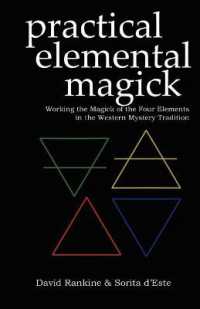- ホーム
- > 洋書
- > 英文書
- > Business / Economics
基本説明
New in paperback. Hardcover was published in 2004. Includes not only the original text but an introduction by Harold Kuhn, an afterword by Ariel Rubinstein, and reviews and articles that appeared at the time of its original publication in the New York Times, the Journal of Economic Perspectives, and other publications.
"Princeton Classic Editions"
Full Description
This is the classic work upon which modern-day game theory is based. What began more than sixty years ago as a modest proposal that a mathematician and an economist write a short paper together blossomed, in 1944, when Princeton University Press published Theory of Games and Economic Behavior. In it, John von Neumann and Oskar Morgenstern conceived a groundbreaking mathematical theory of economic and social organization, based on a theory of games of strategy. Not only would this revolutionize economics, but the entirely new field of scientific inquiry it yielded--game theory--has since been widely used to analyze a host of real-world phenomena from arms races to optimal policy choices of presidential candidates, from vaccination policy to major league baseball salary negotiations. And it is today established throughout both the social sciences and a wide range of other sciences.
This sixtieth anniversary edition includes not only the original text but also an introduction by Harold Kuhn, an afterword by Ariel Rubinstein, and reviews and articles on the book that appeared at the time of its original publication in the New York Times, tthe American Economic Review, and a variety of other publications. Together, these writings provide readers a matchless opportunity to more fully appreciate a work whose influence will yet resound for generations to come.
Contents
PREFACE v TECHNICAL NOTE v ACKNOWLEDGMENT x CHAPTER I: FORMULATION OF THE ECONOMIC PROBLEM 1.THE MATHEMATICAL METHOD IN ECONOMICS 1 1.1. Introductory remarks 1 1.2. Difficulties of the application of the mathematical method 2 1.3. Necessary limitations of the objectives 6 1.4. Concluding remarks 7 2.QUALITATIVE DISCUSSION OF THE PROBLEM OF RATIONAL BEHAVIOR 8 2.1. The problem of rational behavior 8 2.2. "Robinson Crusoe" economy and social exchange economy 9 2.3. The number of variables and the number of participants 12 2.4. The case of many participants: Free competition 13 2.5. The "Lausanne" theory 15 3.THE NOTION OF UTILITY 15 3.1. Preferences and utilities 15 3.2. Principles of measurement: Preliminaries 16 3.3. Probability and numerical utilities 17 3.4. Principles of measurement: Detailed discussion 20 3.5. Conceptual structure of the axiomatic treatment of numerical utilities 24 3.6. The axioms and their interpretation 26 3.7. General remarks concerning the axioms 28 3.8. The role of the concept of marginal utility 29 4.STRUCTURE OF THE THEORY: SOLUTIONS AND STANDARDS OF BEHAVIOR 31 4.1. The simplest concept of a solution for one participant 31 4.2. Extension to all participants 33 4.3. The solution as a set of imputations 34 4.4. The intransitive notion of "superiority" or "domination" 37 4.5. The precise definition of a solution 39 4.6. Interpretation of our definition in terms of "standards of behavior" 40 4.7. Games and social organizations 43 4.8. Concluding remarks 43 CHAPTER II: GENERAL FORMAL DESCRIPTION OF GAMES OF STRATEGY 5.Introduction 46 5.1. Shift of emphasis from economics to games 46 5.2. General principles of classification and of procedure 46 6.THE SIMPLIFIED CONCEPT OF A GAME 48 6.1. Explanation of the termini technici 48 6.2. The elements of the game 49 6.3. Information and preliminary 51 6.4. Preliminarity, transitivity, and signaling 51 7.THE COMPLETE CONCEPT OF A GAME 55 7.1. Variability of the characteristics of each move 55 7.2. The general description 57 8.SETS AND PARTITIONS 60 8.1. Desirability of a set-theoretical description of a game 60 8.2. Sets, their properties, and their graphical representation 61 8.3. Partitions, their properties, and their graphical representation 63 8.4. Logistic interpretation of sets and partitions 66 *9. THE SET-THEORETICAL DESCRIPTION OF A CAME 67 *9.1. The partitions which describe a game 67 *9.2. Discussion of these partitions and their properties 71 *10. AXIOMATIC FORMULATION 73 *10.1. The axioms and their interpretations 73 *10.2. Logistic discussion of the axioms 76 *10.3. General remarks concerning the axioms 76 *10.4. Graphical representation 77 11.STRATEGIES AND THE FINAL SIMPLIFICATION OF THE DESCRIPTION OF THE GAME 79 11.1. The concept of a strategy and its formalization 79 11.2. The final simplification of the description of a game 81 11.3. The role of strategies in the simplified form of a game 84 11.4. The meaning of the zero-sum restriction 84 CHAPTER III: ZERO-SUM TWO-PERSON GAMES: THEORY 12.PRELIMINARY SURVEY 85 12.1. General viewpoints 85 12.2. The one-person game 85 12.3. Chance afid probability 87 12.4. The next objective 87 13.FUNCTIONAL CALCULUS 88 13.1. Basic definitions 88 13.2. The operations Max and Min 89 13.3. Commutativity questions 91 13.4. The mixed case. Saddle points 93 13.5. Proofs of the main facts 95 14.STRICTLY DETERMINED GAMES 98 141. Formulation of the problem 98 14.2. The minorant and the majorant games 100 14.3. Discussion of the auxiliary games 101 14.4. Conclusions 105 14.5. Analysis of strict determinateness 106 14.6. The interchange of players. Symmetry 109 14.7. Non strictly determined games 110 14.8. Program of a detailed analysis of strict determinateness 111 *15. GAMES WITH PERFECT INFORMATION *15.1. Statement of purpose. Induction 112 *15.2. The exact condition (First step) 114 *15.3. The exact condition (Entire induction) 116 *15.4. Exact discussion of the inductive step 117 *15.5. Exact discussion of the inductive step (Continuation) 120 *15.6. The result in the case of perfect information 123 *15.7. Application to Chess 124 *15.8. The alternative, verbal discussion 126 16.LINEARITY AND CONVEXITY 128 16.1. Geometrical background 128 16.2. Vector operations 129 16.3. The theorem of the supporting hyperplanes 134 16.4. The theorem of the alternative for matrices 138 17.MIXED STRATEGIES. THE SOLUTION FOR ALL GAMES 143 17.1. Discussion of two elementary examples 143 17.2. Generalization of this viewpoint 145 17.3. Justification of the procedure as applied to an individual play 146 17.4. The minorant and the majorant games. (For mixed strategies) 149 17.5. General strict determinateness 150 17.6. Proof of the main theorem 153 17.7. Comparison of the treatment by pure and by mixed strategies 155 17.8. Analysis of general strict determinateness 158 17.9. Further characteristics of good strategies 160 17.10. Mistakes and their consequences. Permanent optimality 162 17.11. The interchange of players. Symmetry 165 CHAPTER IV: ZERO-SUM TWO-PERSON GAMES: EXAMPLES 18.SOME ELEMENTARY GAMES 169 18.1. The simplest games 169 18.2. Detailed quantitative discussion of these games 170 18.3. Qualitative characterizations 173 18.4. Discussion of some specific games. (Generalized forms of Matching Pennies) 175 18.5. Discussion of some slightly more complicated games 178 18.6. Chance and imperfect information 182 18.7. Interpretation of this result 185 *19. POKER AND BLUFFING 186 *19.1. Description of Poker 186 *19.2. Bluffing 188 *19.3. Description of Poker (Continued) 189 *19.4. Exact formulation of the rules 190 *19.5. Description of the strategy 191 *19.6. Statement of the problem 195 *19.7. Passage from the discrete to the continuous problem 196 *19.8. Mathematical determination of the solution 199 *19.9. Detailed analysis of the solution 202 *19.10. Interpretation of the solution 204 *19.11. More general forms of Poker 207 *19.12. Discrete hands 208 *19.13. m possible bids 209 *19.14. Alternate bidding 211 *19.15. Mathematical description of all solutions 216 *19.16. Interpretation of the solutions. Conclusions 218 CHAPTER V: ZERO-SUM THREE-PERSON GAMES 20.PRELIMINARY SURVEY 220 20.1. General viewpoints 220 20.2. Coalitions 221 21.THE SIMPLE MAJORITY GAME OF THREE PERSONS 222 21.1. Definition of the game 222 21.2. Analysis of the game: Necessity of "understandings" 223 21.3. Analysis of the game: Coalitions. The role of symmetry 224 22.FURTHER EXAMPLES 225 22.1. Unsymmetric distributions. Necessity of compensations 225 22.2. Coalitions of different strength. Discussion 227 22.3. An inequality. Formulae 229 23.THE GENERAL CASE 231 23.1. Detailed discussion. Inessential and essential games 231 23.2. Complete formulae 232 24.DISCUSSION OF AN OBJECTION 233 24.1. The case of perfect information and its significance 233 24.2. Detailed discussion. Necessity of compensations between three or more players 235 CHAPTER VI: FORMULATION OF THE GENERAL THEORY: ZERO-SUM n-PERSON GAMES 25.THE CHARACTERISTIC FUNCTION 238 25.1. Motivation and definition 238 25.2. Discussion of the concept 240 25.3. Fundamental properties 241 25.4. Immediate mathematical consequences 242 26.CONSTRUCTION OF A GAME WITH A GIVEN CHARACTERISTIC FUNCTION 243 26.1. The construction 243 26.2. Summary 245 27.STRATEGIC EQUIVALENCE. INESSENTIAL AND ESSENTIAL GAMES 245 27.1. Strategic equivalence. The reduced form 245 27.2. Inequalities. The quantity [gamma] 248 27.3. Inessentiality and essentiality 249 27.4. Various criteria. Non additive utilities 250 27.5. The inequalities in the essential case 252 27.6. Vector operations on characteristic functions 253 28.GROUPS, SYMMETRY AND FAIRNESS 255 28.1. Permutations, their groups and their effect on a game 255 28.2. Symmetry and fairness 258 29.RECONSIDERATION OF THE ZERO-SUM THREE-PERSON GAME 260 29.1. Qualitative discussion 260 29.2. Quantitative discussion 262 30.THE EXACT FORM OF THE GENERAL DEFINITIONS 263 30.1. The definitions 263 30.2. Discussion and recapitulation 265 *30.3. The concept of saturation 266 30.4. Three immediate objectives 271 31.FIRST CONSEQUENCES 272 31.1. Convexity, flatness, and some criteria for domination 272 31.2. The system of all imputations. One element solutions 277 31.3. The isomorphism which corresponds to strategic equivalence 281 32.DETERMINATION OF ALL SOLUTIONS OF THE ESSENTIAL ZERO-SUM THREE-PERSON GAME 282 32.1. Formulation of the mathematical problem. The graphical method 282 32.2. Determination of all solutions 285 33.CONCLUSIONS 288 33.1. The multiplicity of solutions. Discrimination and its meaning 288 33.2. Statics and dynamics 290 CHAPTER VII: ZERO-SUM FOUR-PERSON GAMES 34.PRELIMINARY SURVEY 291 34.1. General viewpoints 291 34.2. Formalism of the essential zero sum four person games 291 34.3. Permutations of the players 294 35.DISCUSSION OF SOME SPECIAL POINTS IN THE CUBE Q 295 35.1. The corner I. (and V., VI., VII.) 295 35.2. The corner VIII. (and II., III., IV.,). The three person game and a "Dummy" 299 35.3. Some remarks concerning the interior of Q 302 36.DISCUSSION OF THE MAIN DIAGONALS 304 36.1. The part adjacent to the corner VIII.: Heuristic discussion 304 36.2. The part adjacent to the corner VIII.: Exact discussion 307 *36.3. Other parts of the main diagonals 312 37.THE CENTER AND ITS ENVIRONS 313 37.1. First orientation about the conditions around the center 313 37.2. The two alternatives and the role of symmetry 315 37.3. The first alternative at the center 316 37.4. The second alternative at the center 317 37.5. Comparison of the two central solutions 318 37.6. Unsymmetrical central solutions 319 *38. A FAMILY OF SOLUTIONS FOR A NEIGHBORHOOD OF THE CENTER 321 *38.1. Transformation of the solution belonging to the first alternative at the center 321 *38.2. Exact discussion 322 *38.3. Interpretation of the solutions 327 CHAPTER VIII: SOME REMARKS CONCERNING n [equal to or greater than] 5 PARTICIPANTS 39.THE NUMBER OF PARAMETERS IN VARIOUS CLASSES OF GAMES 330 39.1. The situation for n = 3, 4 330 39.2. The situation for all n [equal to or greater than] 3 330 40.THE SYMMETRIC FIVE PERSON GAME 332 40.1. Formalism of the symmetric five person game 332 40.2. The two extreme cases 332 40.3. Connection between the symmetric five person game and the 1, 2, 3 symmetric four person game 334 CHAPTER IX: COMPOSITION AND DECOMPOSITION OF GAMES 41.COMPOSITION AND DECOMPOSITION 339 41.1. Search for n-person games for which all solutions can be determined 339 41.2. The first type. Composition and decomposition 340 41.3. Exact definitions 341 41.4. Analysis of decomposability 343 41.5. Desirability of a modification 345 42.MODIFICATION OF THE THEORY 345 42.1. No complete abandonment of the zero sum restriction 345 42.2. Strategic equivalence. Constant sum games 346 42.3. The characteristic function in the new theory 348 42.4. Imputations, domination, solutions in the new theory 350 42.5. Essentiality, inessentiality and decomposability in the new theory 351 43.THE DECOMPOSITION PARTITION 353 43.1. Splitting sets. Constituents 353 43.2. Properties of the system of all splitting sets 353 43.3. Characterization of the system of all splitting sets. The decomposition partition 354 43.4. Properties of the decomposition partition 357 44.DECOMPOSABLE GAMES. FURTHER EXTENSION OF THE THEORY 358 44.1. Solutions of a (decomposable) game and solutions of its constituents 358 44.2. Composition and decomposition of imputations and of sets of imputations 359 44.3. Composition and decomposition of solutions. The main possibilities and surmises 361 44.4. Extension of the theory. Outside sources 363 44.5. The excess 364 44.6. Limitations of the excess. The non-isolated character of a game in the new setup 366 44.7. Discussion of the new setup. E(e0), F(e0) 367 45.LIMITATIONS OF THE EXCESS. STRUCTURE OF THE EXTENDED THEORY 378 45.1. The lower limit of the excess 368 45.2. The upper limit of the excess. Detached and fully detached imputations 369 45.3. Discussion of the two limits, |[Gamma]|1, |[Gamma]|2. Their ratio 372 45.4. Detached imputations and various solutions. The theorem connecting E(e0), F(e0) 375 45.5. Proof of the theorem 376 45.6. Summary and conclusions 380 46.DETERMINATION OF ALL SOLUTIONS OF A DECOMPOSABLE GAME 381 46.1. Elementary properties of decompositions 381 46.2. Decomposition and its relation to the solutions: First results concerning F(e0) 384 46.3. Continuation 386 46.4. Continuation 388 46.5. The complete result in F(e0) 390 46.6. The complete result in E(e0) 393 46.7. Graphical representation of a part of the result 394 46.8. Interpretation: The normal zone. Heredity of various properties 396 46.9. Dummies 397 46.10. Imbedding of a game 398 46.11. Significance of the normal zone 401 46.12. First occurrence of the phenomenon of transfer: n = 6 402 47.THE ESSENTIAL THREE-PERSON GAME IN THE NEW THEORY 403 47.1. Need for this discussion 403 47.2. Preparatory considerations 403 47.3. The six cases of the discussion. Cases (I)-(III) 406 47.4. Case (IV): First part 407 47.5. Case (IV): Second part 409 47.6. Case (V) 413 47.7. Case (VI) 415 47.8. Interpretation of the result: The curves (one dimensional parts) in the solution 416 47.9. Continuation: The areas (two dimensional parts) in the solution 418 CHAPTER X: SIMPLE GAMES 48.WINNING AND LOSING COALITIONS AND GAMES WHERE THEY OCCUR 420 48.1. The second type of 41.1. Decision by coalitions 420 48.2. Winning and Losing Coalitions 421 49.CHARACTERIZATION OF THE SIMPLE GAMES 423 49.1. General concepts of winning and losing coalitions 423 49.2. The special role of one element sets 425 49.3. Characterization of the systems W, L of actual games 426 49.4. Exact definition of simplicity 428 49.5. Some elementary properties of simplicity 428 49.6. Simple games and their W, L. The Minimal winning coalitions: Wm 429 49.7. The solutions of simple games 430 50.THE MAJORITY GAMES AND THE MAIN SOLUTION 431 50.1. Examples of simple games: The majority games 481 50.2. Homogeneity 433 50.3. A more direct use of the concept of imputation in forming solutions 435 50.4. Discussion of this direct approach 436 50.5. Connections with the general theory. Exact formulation 438 50.6. Reformulation of the result 440 50.7. Interpretation of the result 442 50.8. Connection with the Homogeneous Majority game 443 51.METHODS FOR THE ENUMERATION OF ALL SIMPLE GAMES 445 51.1. Preliminary Remarks 445 51.2. The saturation method: Enumeration by means of W 446 51.3. Reasons for passing from W to Wm. Difficulties of using Wm 448 51.4. Changed Approach: Enumeration by means of Wm 450 51.5. Simplicity and decomposition 452 51.6. Inessentiality, Simplicity and Composition. Treatment of the excess 454 51.7. A criterium of decomposability in terms of Wm 455 52.THE SIMPLE GAMES FOR SMALL n 457 52.1. Program. n = 1, 2 play no role. Disposal of n = 3 457 52.2. Procedure for n [equal to or greater than] 4: The two element sets and their role in classify ing the Wm 458 52.3. Decomposability of cases C*, Cn-2, Cn-1 459 52.4. The simple games other than [1, ... , 1, n - 2]h, (with dummies): The Cases Ck, k = 0, 1, ... , n - 3 461 52.5. Disposal of n = 4, 5 462 53.THE NEW POSSIBILITIES OF SIMPLE GAMES FOR n [equal to or greater than] 6 463 53.1. The Regularities observed for n [equal to or greater than] 6 463 53.2. The six main counter examples (for n = 6, 7) 464 54.DETERMINATION OF ALL SOLUTIONS IN SUITABLE GAMES 470 54.1. Reasons to consider other solutions than the main solution in simple games 470 54.2. Enumeration of those games for which all solutions are known 471 54.3. Reasons to consider the simple game [1, ... , 1, n - 2]h, 472 *55. THE SIMPLE GAME [1, ... , 1, n - 2]h 473 *55.1. Preliminary Remarks 473 *55.2. Domination. The chief player. Cases (I) and (11) 473 *55.3. Disposal of Case (I) 475 *55.4. Case (II): Determination of V [above horizontal bar] 478 *55.5. Case (II): Determination of V [below horizontal bar] 481 *55.6. Case (II): [alpha] and S* 484 *55.7. Case (II') and (II"). Disposal of Case (II') 485 *55.8. Case (II"): [alpha] and V'. Domination 488 *55.9. Case (II"): Determination of V' *55.10. Disposal of Case (II") 488 *55.11. Reformulation of the complete result 497 *55.12. Interpretation of the result 499 CHAPTER XI: GENERAL NON-ZERO-SUM GAMES 56.EXTENSION OF THE THEORY 504 56.1. Formulation of the problem 504 56.2. The fictitious player. The zero sum extension [Gamma] 505 56.3. Questions concerning the character of [Gamma below horizontal bar] 506 56.4. Limitations of the use of [Gamma above horizontal bar] 508 56.5. The two possible procedures 510 56.6. The discriminatory solutions 511 56.7. Alternative possibilities 512 56.8. The new setup 514 56.9. Reconsideration of the case when [Gamma] is a zero sum game 516 56.10. Analysis of the concept of domination 520 56.11. Rigorous discussion 523 56.12. The new definition of a solution 526 57.THE CHARACTERISTIC FUNCTION AND RELATED TOPICS 527 57.1. The characteristic function: The extended and the restricted form 527 57.2. Fundamental properties 528 57.3. Determination of all characteristic functions 530 57.4. Removable sets of players 533 57.5. Strategic equivalence. Zero-sum and constant-sum games 535 58.INTERPRETATION OF THE CHARACTERISTIC FUNCTION 538 58.1. Analysis of the definition 538 58.2. The desire to make a gain vs. that to inflict a loss 539 58.3. Discussion 541 59.GENERAL CONSIDERATIONS 542 59.1. Discussion of the program 542 59.2. The reduced forms. The inequalities 543 59.3. Various topics 546 60.THE SOLUTIONS OF ALL GENERAL GAMES WITH n [equal to or less than] 3 548 60.1. The case n = 1 548 60.2. The case n = 2 549 60.3. The case n = 3 550 60.4. Comparison with the zero sum games 554 61.ECONOMIC INTERPRETATION OF THE RESULTS FOR n = 1, 2 555 61.1. The case n = 1 555 61.2. The case n = 2. The two person market 555 61.3. Discussion of the two person market and its characteristic function 557 61.4. Justification of the standpoint of 58 559 61.5. Divisible goods. The "marginal pairs" 560 61.6. The price. Discussion 562 62.ECONOMIC INTERPRETATION OF THE RESULTS FOR n = 3: SPECIAL CASE 564 62.1. The case n = 3, special case. The three person market 564 62.2. Preliminary discussion 566 62.3. The solutions: First subcase 566 62.4. The solutions: General form 569 62.5. Algebraical form of the result 570 62.6. Discussion 571 63.ECONOMIC INTERPRETATION OF THE RESULTS FOR n = 3: GENERAL CASE 573 63.1. Divisible goods 573 63.2. Analysis of the inequalities 575 63.3. Preliminary discussion 577 63.4. The solutions 577 63.5. Algebraical form of the result 580 63.6. Discussion 581 64.THE GENERAL MARKET 583 64.1. Formulation of the problem 583 64.2. Some special properties. Monopoly and monopsony 584 CHAPTER XII: EXTENSION OF THE CONCEPTS OF DOMINATION AND SOLUTION 65.THE EXTENSION. SPECIAL CASES 587 65.1. Formulation of the problem 587 65.2. General remarks 588 65.3. Orderings, transitivity, acyclicity 589 65.4. The solutions: For a symmetric relation. For a complete ordering 591 65.5. The solutions: For a partial ordering 592 65.6. Acyclicity and strict acyclicity 594 65.7. The solutions: For an acyclic relation 597 65.8. Uniqueness of solutions, acyclicity and strict acyclicity 600 65.9. Application to games: Discreteness and continuity 602 66.GENERALIZATION OF THE CONCEPT OF UTILITY 603 66.1. The generalization. The two phases of the theoretical treatment 603 66.2. Discussion of the first phase 604 66.3. Discussion of the second phase 606 66.4. Desirability of unifying the two phases 607 67.DISCUSSION OF AN EXAMPLE 608 67.1. Description of the example 608 67.2. The solution and its interpretation 611 67.3. Generalization: Different discrete utility scales 614 67.4. Conclusions concerning bargaining 616 APPENDIX: THE AXIOMATIC TREATMENT OF UTILITY 617 INDEX OF FIGURES 633 INDEX OF NAMES 634 INDEX OF SUBJECTS 635








